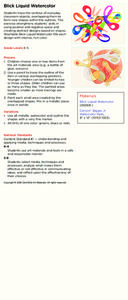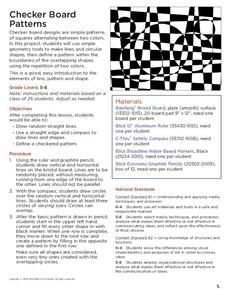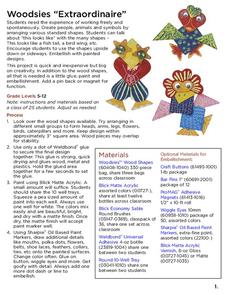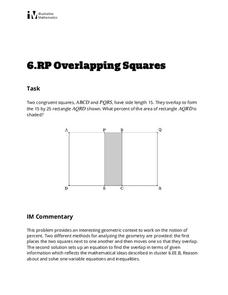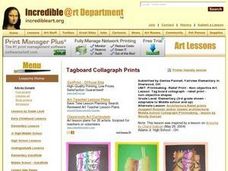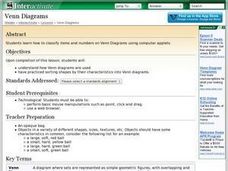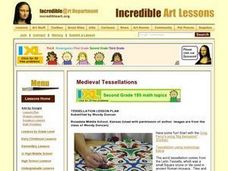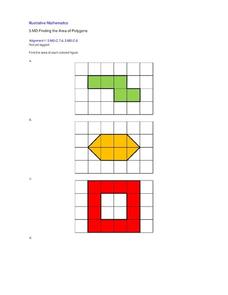Illustrative Mathematics
Overlapping Rectangle
Challenge young mathematicians' ability to compose and decompose shapes with this fun geometry puzzle. The goal is simple, locate all of the rectangles shown in a picture of three overlapping rectangles. Perform this activity as a whole...
Curated OER
Shape Collages
To reinforce shape recognition and identification, little learners create a shape collage. They name each shape as they go, gluing or pasting them onto bright paper. They discuss collage techniques and are encouraged to use their shapes...
Curated OER
Blick Liquid Watercolor
Introduce this abstract art to your class; they must chose ordinary classroom objects and shapes to paint with watercolors. The overlapping effect will create a fun, abstract piece of art!
Curated OER
Checker Board Patterns
Make these funky checker board patterns. They will not only add fun decoration to your classroom, but your pupils will be able to practice using simple geometry tools.They will use tools to make lines and circular shapes using a ruler,...
Curated OER
Line of Symmetry
Where is the line of symmetry in these shapes? Review this concept using the visual guide at the top of the page, explaining how some shapes have multiples lines. Consider demonstrating this concept with large cut-outs, physically...
Curated OER
Woodsies "Extraordinaire"
Allow your class to use their imaginations and create fun creatures with various wooden shapes and other embellishments. What a great way to encourage your young artists to stretch their minds!
Curated OER
Shape Collage Pizza
Students identify shapes. In this geometry lesson plan, students cut out various shapes and create a "Shape Collage Pizza." Students glue their shapes onto a pizza template.
Illustrative Mathematics
Overlapping Squares
The objective of this activity is to find the percent of the area of a two squares overlapping. Mathematicians find the ratio of area for the part that overlaps to the rectangle formed. The final answer is a percent as a rate per 100....
Shodor Education Foundation
Overlapping Gaussians
Adjust the overlap to compare probabilities. Using sliders, learners adjust the shape of two Gaussian curves. The interactive calculates the area of the left tail for one curve and the right tail for the other. Pupils set the interactive...
Curated OER
Tag Board Collagraph - Relief Print - Non-Objective Shapes
Students create their own collagraph relief plate and print. Using basic shapes, they develop a center of interest within their relief plate. They also create a non-objective design with shapes using the principles of design. They are...
Curated OER
Size, Shape, and Color
Students demonstrate that they can identify simple geometric shapes and compare them by color and size accordingly: by the main shapes, sizes, and color. They comprehend the names of the sizes, shapes and colors in the target language.
Curated OER
Line and Shape Game
Learners play the "space-breaker" game, in which they are required to create a picture using shapes or lines called out to them) to reinforce the concept of geometric shape and line.
Curated OER
Venn Diagram and Shape Sorting Lesson Plan
Learners use Venn diagrams to represent classifications of shapes and to use counting arguments to find the number of objects in a given set.
Curated OER
Angles Activities
A series of geometry worksheets have mathematicians constructing, dissecting, overlapping, and measuring as they analyze angles in various contexts. Learners use symmetry and reflections in a compass rose to write instructions on...
Curated OER
Forests and Treescapes with Romey Stuckart
Students discuss Romey Stuckart's painting, "The Cedar," paint a tempera or acrylic picture of a forest or treescape, using overlapping shapes, intense hues, and heavy brush textures, and discuss managed forest techniques preserve...
Curated OER
Keeping in Shape
Third graders describe patterns in terms of reflection and rotation symmetry, and translations. They design and make a pattern which involves translation, reflection, or rotation. They demonstrate why a given tessellation covers the...
Curated OER
Screen printing - Positive-Negative shape - Paper stencils
Students explore materials and experiment with stencil process. Students study positive verses negative shape. They experiment with color planning and learn what happens when colors overlap. They work with personal symbols and/or...
Pennsylvania Department of Education
A Geometric Scavenger Hunt
Fifth graders connect their knowledge of polygons and polyhedrons. In this geometric shapes lesson, 5th graders identify and classify two- and three-dimensional objects. Students construct a polyhedron out of polygons and describe their...
Curated OER
Geometry of Democracy
Young scholars explore the architecture of New England by identifying geometric shapes. In this architectural lesson, students examine photographs of classic building architecture and use a transparency to trace geometric shapes...
Curated OER
Tessellation Lesson Plan
Students produce original tessellations, using equilateral triangles where three unique symmetrical faces rotate, use shape, pattern/repetition, and color to create a striking composition, and create "beasties" inspired by bestiaries of...
Curated OER
Introducing Powers and Models
Students construct two dimensional models to illustrate squared numbers. In this geometry lesson, students use graph paper and an x/y axis to build squares exponentially. Students identify powers and relationships between various figures...
Dick Blick Art Materials
Woodsies “Extraordinaire”
"This looks like an owl!" Kids get a chance to create all sorts of things by arranging various shapes, painting them, and gluing them together. A great way to encourage creativity and spontaneity.
Curated OER
Finding the Area of Polygons
Third graders are exposed to finding the area of polygons by decomposing figures and recomposing them into rectangles. This strategy allows children to expand on their prior knowledge of constructing shapes by rearranging parts into...
Curated OER
"Polly"gon Pockets
Explore polygons with your elementary learners. Divide the class in 12 to configure the polygon puzzle before them. They list the attributes of each type of polygon they see, and if there's time, they jump on the interactive website...




